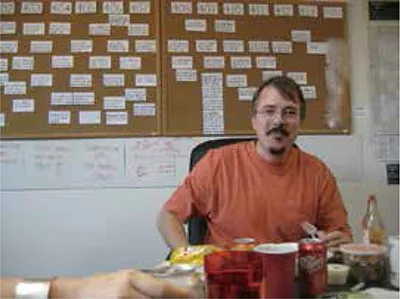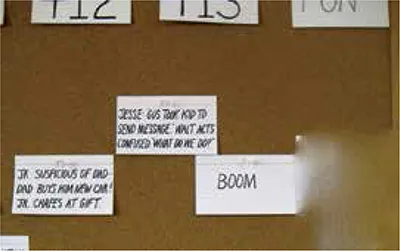
eBook - ePub
The User's Journey
Storymapping Products That People Love
Donna Lichaw
This is a test
Condividi libro
- 160 pagine
- English
- ePUB (disponibile sull'app)
- Disponibile su iOS e Android
eBook - ePub
The User's Journey
Storymapping Products That People Love
Donna Lichaw
Dettagli del libro
Anteprima del libro
Indice dei contenuti
Citazioni
Informazioni sul libro
Like a good story, successful design is a series of engaging moments structured over time. The User’s Journey will show you how, when, and why to use narrative structure, technique, and principles to ideate, craft, and test a cohesive vision for an engaging outcome. See how a “story first” approach can transform your product, feature, landing page, flow, campaign, content, or product strategy.
Domande frequenti
Come faccio ad annullare l'abbonamento?
È semplicissimo: basta accedere alla sezione Account nelle Impostazioni e cliccare su "Annulla abbonamento". Dopo la cancellazione, l'abbonamento rimarrà attivo per il periodo rimanente già pagato. Per maggiori informazioni, clicca qui
È possibile scaricare libri? Se sì, come?
Al momento è possibile scaricare tramite l'app tutti i nostri libri ePub mobile-friendly. Anche la maggior parte dei nostri PDF è scaricabile e stiamo lavorando per rendere disponibile quanto prima il download di tutti gli altri file. Per maggiori informazioni, clicca qui
Che differenza c'è tra i piani?
Entrambi i piani ti danno accesso illimitato alla libreria e a tutte le funzionalità di Perlego. Le uniche differenze sono il prezzo e il periodo di abbonamento: con il piano annuale risparmierai circa il 30% rispetto a 12 rate con quello mensile.
Cos'è Perlego?
Perlego è un servizio di abbonamento a testi accademici, che ti permette di accedere a un'intera libreria online a un prezzo inferiore rispetto a quello che pagheresti per acquistare un singolo libro al mese. Con oltre 1 milione di testi suddivisi in più di 1.000 categorie, troverai sicuramente ciò che fa per te! Per maggiori informazioni, clicca qui.
Perlego supporta la sintesi vocale?
Cerca l'icona Sintesi vocale nel prossimo libro che leggerai per verificare se è possibile riprodurre l'audio. Questo strumento permette di leggere il testo a voce alta, evidenziandolo man mano che la lettura procede. Puoi aumentare o diminuire la velocità della sintesi vocale, oppure sospendere la riproduzione. Per maggiori informazioni, clicca qui.
The User's Journey è disponibile online in formato PDF/ePub?
Sì, puoi accedere a The User's Journey di Donna Lichaw in formato PDF e/o ePub, così come ad altri libri molto apprezzati nelle sezioni relative a Design e Product Design. Scopri oltre 1 milione di libri disponibili nel nostro catalogo.
Informazioni
CHAPTER 1

Mapping the Story
Making Things Go BOOM!
Why Story?
“You need a road map, a guide, a direction—a line of development leading from beginning to end. You need a story line. If you don’t have one, you’re in trouble.”
—Syd Field,
Screenplay: The Foundations of Screenwriting
Screenplay: The Foundations of Screenwriting
In 2004, I presented my year-end documentary film in graduate school to an audience of around 100 people. As soon as the film ended, before the lights went up, one of my classmate’s hands shot up. I will never forget the first words he uttered—they’re etched into my brain.
I can’t believe you made me sit through that. What was the point?
My film was a dud. It had nothing holding it together: no conflict, no climax, and no resolution—ergo, no story. As a result, I failed to engage my audience. I somehow forgot one of the foundational tenets of filmmaking: if you want to engage your audience, your film must have a story at its foundation.
A website, software, app, service, or campaign—for brevity’s-sake I’ll use the term product for the rest of the book—is similar to a film. They are all things that humans experience. Just like with a film, if you want to engage your audience, your product must have a story at its foundation. You can do this by accident like I did when I created films that people loved. (I did have a few of those, I promise.) Or you can map the story with deliberate care and intent like I eventually learned to do, both as a filmmaker and more recently as someone who helps businesses build products that people love.
Making Things Go BOOM!
Vince Gilligan, creator of the television show Breaking Bad, knows a thing or two about using story to engage an audience. In this photo (see Figure 1.1), he is seated in front of the story map for Season 4.
TV writers are smart. They map the story out before they write a line of dialogue or shoot a single scene. TV shows are large, complex things that are built with large, distributed teams over a long period of time. With so many people, scenes, episodes, and seasons to manage, it’s hard to stay focused on the big picture. Mapping the story on a wall helps TV writers plot a course while keeping the big picture in mind.

FIGURE 1.1
Vince Gilligan, creator of Breaking Bad, in front of a story map for season 4.
Vince Gilligan, creator of Breaking Bad, in front of a story map for season 4.
Mapping the story also helps TV writers build a product that engages an audience by adhering to a millennia-old architecture designed for engagement: a well-crafted story. You’ll learn more about story architecture in Chapter 2, but in the meantime, consider this meticulously placed card near the end of the storyline for Breaking Bad, Season 4 (see Figure 1.2). This card has one word written on it: “BOOM.” If you’ve seen Season 4 of Breaking Bad, you know what this refers to. If you haven’t, you can imagine. Mapping the story helps TV writers make things go BOOM. And it will help you, someone who builds products, make things go BOOM as well.
Story is why people tune in and stayed tuned in, whether you’re creating a TV show, a movie, or a website. Storymapping is how you make that story happen, whether you’re a screenwriter or a product person.

FIGURE 1.2
A close-up of a story card for Breaking Bad.
A close-up of a story card for Breaking Bad.
Storymapping is just what it sounds like: mapping out an intended experience of use for a product, plot point by plot point. This concept of mapping stories is not new. It’s something that Aristotle started doing a very long time ago as he sought to understand what it was about Greek dramas that enraptured audiences, so their success could be reproduced. It’s something screenwriters have been doing for years. It’s something I eventually learned to do for films and more recently with products. And it’s something that you can do on your next project or product.
Why Story?
Story is one of the most powerful tools that humans use to understand and communicate with the outside world. Part evolutionary feature, part survival mechanism harking back to Paleolithic times, part communication tool—story powers the human brain. Story-based cognitive function is so powerful that neuroscientists have a term for it when it doesn’t work: dysnarrativia, the inability to understand or construct stories. Narrative cognition is so central to how humans operate that not having it is debilitating. Like living with amnesia, it is difficult, if not impossible, to function normally. Story, and its underlying architecture, powers the ability to understand what happened in the past, what happens in the moment, or what will happen in the future. It’s a framework and a lens with which humans comprehend everything.
Whether you plan for it or not, your customers use their story-driven brains to understand your product and what it’s like to use your product. They also use their story-driven brains to tell others about your product. The better the story, the better the experience, the better the word of mouth.
More specifically, when people experience something with a story at its foundation—whether it entails watching a movie, riding a roller-coaster, or using a website—their brains are activated. They are more likely not just to have a good experience, but to:
• Remember the experience.
• See value in what was experienced.
• See utility in what they did during that experience.
• Have an easier time doing whatever they were trying to accomplish.
• Want to repeat that experience.
All of this fits under the umbrella of engagement.
If you’re in the business of building products that engage, it’s your job to consider the story that you and your business want your customers to experience. In this book, you will learn how to map that story—or stories—and align everything you and your business do so that it supports that story. For your customer. And your business.
It works for movies, and it will work for you.
NOTE THE OR A STORY VS. STORY
It may look as if I’ve made a mistake throughout this book by using the word “story” without an article in front of it, i.e., the story. It’s no mistake. Story is as much of a tool and framework as it is a discipline. Like art. Or science. When I use “story” without the article, I’m talking about story as a tool. For example, I might say “use story to turn data into insights.” However, if I refer to “a story” or “the story,” I’m referring to the thing you will create and weave throughout your work.
CHAPTER 2

How Story Works
Story Has a Structure
Building Products with Story
“For, the more we look at the story (the story that is a story, mind), the more we disentangle it from the finer growths that it supports, the less shall we find to admire. It runs like a backbone—or may I say a tape-worm, for its beginning and end are arbitrary.”
—E. M. Forster,
Aspects of the Novel
Aspects of the Novel
Humans are sense-making creatures, and story is our most critical sense-making tool. As humans, we’ve evolved and innovated story over millennia as a way to understand our world. For example, there is evidence that ancient cave dwellers learned how to trap an animal and not go hunting alone through the use of stories.
Given how long we’ve lived with story, it’s not surprising that Aristotle uncovered a working model for it long ago. Basically, he said that every story needs three things: characters, goals, and conflict. What weaves these elements together is a structure or a series of actions and events that have a shape to them.
Fortunately, story and its underlying structure is straightforward, simple, and can be easily learned. That’s why it’s so powerful—for books, films, and products.
NOTE STORY VS. NARRATIVE VS. PLOT
Don’t think that you’re alone if you confuse the words story, storyline, plot, and narrative as they are often used interchangeably. Even the dictionary will define them similarly. While story or narrative can refer to the broader version of events, and plot or storyline breaks down the “plan” or series of actions and events that lead up to the story, I use them in this book interchangeably. The reason for this is that a story without a plot or storyline (i....